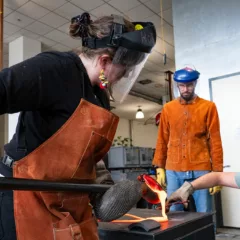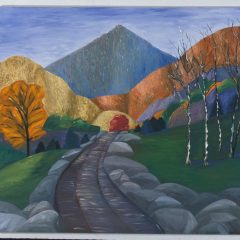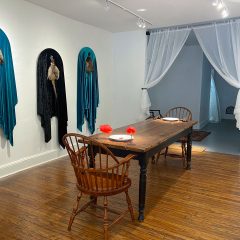What started as a New York survey project of building surfaces, conducted by the Seattle duo Lead Pencil Studio, has led to an exploration of space which dances between architecture and art. Tyler School of Art’s Temple Gallery is currently hosting Lead Pencil’s show Surface Deposit (2010), which examines the build up of materials like pipes, conduits and lamps that encrust urban structures.
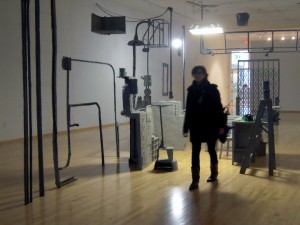
Lead Pencil Studio consists of Annie Han and Daniel Mihalyo, who both come from strong architectural backgrounds. They seek out artistic projects that extend across multiple disciplines, but are rooted in spatial conditions and large-scale installations. Surface Deposit is a work that originated from a previous project called Looking at Nothing (2010). Han and Mihalyo utilized Laser Infrared Detection and Ranging (LIDAR) technology to map the vertical surfaces along streets in New York. The team quickly became interested in the realization that the laser scans were not providing detailed images of the architectural surface, but instead, of the items deposited on the structure’s surface. This inspired them to create a work based on those deposits, thereby enabling viewers to reconsider what they view as they walk down the street. This installation is also tied to Tyler in a more personal way, due to some of the interior objects being salvaged from its former campus in the Philadelphia suburb, Elkins Park.
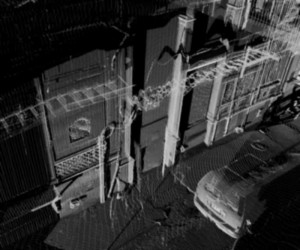
As I entered the gallery space, the monotone selection of gray, with splashes of green, yellow and red, gave the space a deserted, ruined feel. The edges of the objects and forms are punched with holes, causing this non-room to have an evaporating effect, waffling between solid and illusory. Yet, the work still holds an aesthetic quality. I enjoyed the patterns created by often ignored items on a buildings façade. For examples, the pipes cascading from a now invisible roof or the angles created by the railing of a rooftop ladder echoed in a diamond-grated gate. These subtle choices elevate an otherwise bare-boned structure into a curious artistic work. In the screening room, a short film called Urban Fragments I (2010) provides a glimpse into Lead Pencil’s process and original survey renderings. Piled against one wall are some of the reference objects used in creating their unusual space, from chairs and filing cabinets to pipes and signage.
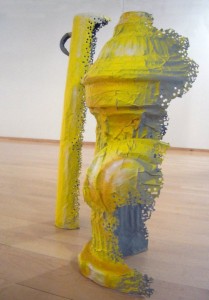
Lead Pencil Studio had restricted dimensions to work within when creating this indoor, site-specific work. My initial reaction to the created space was that it was smaller in scale than I anticipated, having browsed their past installations. However, they did do a great job tailoring their work to the gallery space. Also, the relocation of the building exterior to an interior space allows the work to act as an art form first, and an architectural structure second. Yet, it still would be interesting to see and approach this structure in an outdoor environment. As Lead Pencil Studio explained it, their work is like “architecture in reverse…our projects are everything about architecture with none of its function…spaces with no greater purpose than to be perceived and question the certainty posited by the man-made world.”
On Mondays in January through February, Temple Gallery will be screening films that have been influential to Lead Pencil Studio’s practice. They will include documentaries on the work of Gordon Matta Clark, the early films of Buster Keaton, Luc Besson’s The Fifth Element (1997), and more. On February 2, the gallery will host a panel discussion titled, Beyond the Surface: A Conversation Between Art and Architecture. This will focus on “exploring the work of artists and architects engaged in spatial practices.”
Surface Deposit will be on display until February 26, 2011. The gallery is open Wednesday – Saturday, from 11 am – 6 pm.
*All photos and quotes courtesy of Temple Gallery and Lead Pencil Studio


